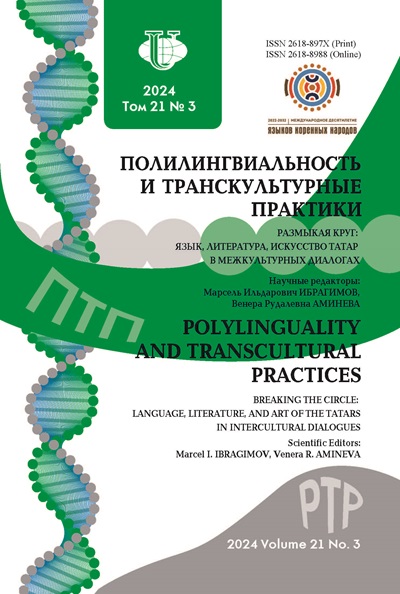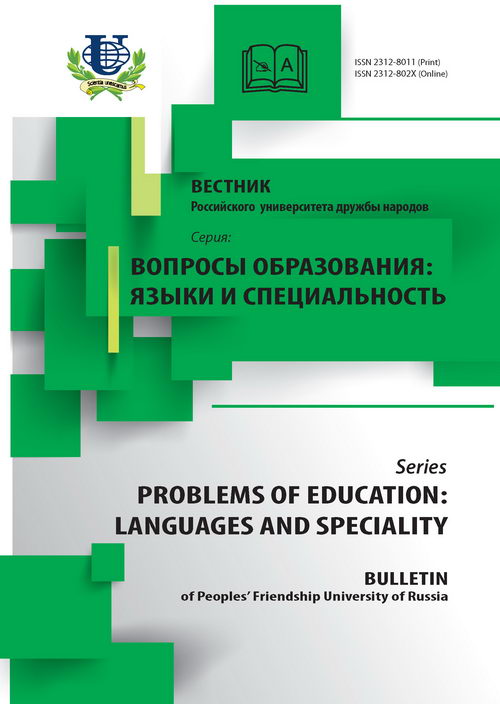No 1 (2016)
Articles
IT’S ALWAYS DIFFICULT TO THE FIRST...(The Foreword to a recent article of Larry Smith)
Abstract
Written in the genre of preface, this introductory article is a metatext to the paper by Larry Smith - one of the founders of World Englishes Paradigm. The goal is to introduce to the readers all necessary information about L. Smith and one of his most recent work program, dedicated to understanding and description of the new paradigm.
Polylinguality and Transcultural Practices. 2016;(1):9-13
 9-13
9-13


FAMILIAR ISSUES FROM A WORLD ENGLISHES PERSPECTIVE
Abstract
This paper does not introduce new “issues”, “positions” or “topics” but instead suggests a fresh perspective on some classic themes in English Language Teaching (ELT). The fresh perspective is that provided by the concept of world Englishes.
Polylinguality and Transcultural Practices. 2016;(1):14-18
 14-18
14-18


ACTIVE STYLISTICALLY RELEVANT PROCESSES AS A RESULT OF FOREGROUNDING OF LINGUISTIC DEVIATIONS(using the materials of English and Russian)
Abstract
The article considers the distinctive features of active stylistically relevant processes determined by the initial foregrounding of different types of linguistic deviation in English and Russian. The key specificity of such kinds of stylistically relevant processes is provided by the fact that the deviant linguistic forms as a means of realizing creative potential of language become normative and introduce some changes in the national language development.
Polylinguality and Transcultural Practices. 2016;(1):19-27
 19-27
19-27


SPECIFICITY OF THE LANGUAGE CHOICE IN A MULTILINGUAL SOCIETY
Abstract
The article deals with the specificity of the Russian language and the Kazakh language functioning in the contemporary space of Kazakhstan. Examples of the use of material ciulture nomination are given. The results show how the choice of languages and changes in their use are happening.
Polylinguality and Transcultural Practices. 2016;(1):28-36
 28-36
28-36


CORPORA APPROACH TOWARDS THE FIXATION OF SPEECHPHENOMENA (on the material of the lexeme knowledge)
Abstract
The article discusses some topical issues of modern linguistics which are dedicated to the discrepancies in understanding of emerging unconventional speech phenomena described from the points of prescriptive and descriptive grammars. The study was conducted in the context of a new methodological approach ensured with the involvement of the analysis of the text language corpora. The data of the lexeme knowledge occurrences in the English language corpora BNC and COCA were used as the material for the study. The collocation peculiarities of the studied lexeme are focused, which made it possible to reveal the mismatching of semantic fields and speech usages of the units knowledge and knowledges in Modern English.
Polylinguality and Transcultural Practices. 2016;(1):37-46
 37-46
37-46


MULTIMEDIA AS AN INSTRUMENT OF LINGUISTIC REALIA VISUALISING
Abstract
The article discusses the usage of electronic educational Russian language teaching resources in a situation of a changing world and the growing people’s needs to receipt a qualitatively new level of interactive and demonstrative information. Particular attention is paid to the instruments, operating on multimedia technologies, discussed in detail their educational potential in the process of Russian language teaching. As a key potential to the achievement of language acquisition and learning is emphasized a linguistic realia visualizing. In work are given, described and illustrated specific examples of multimedia resources, which are contribute linguistic realia visualizing during the teaching different linguistic’s parts.
Polylinguality and Transcultural Practices. 2016;(1):47-55
 47-55
47-55


ANALYSIS OF THE STRUCTURE OF ENGINEERING DISCOURSE / TEXT AS A BASIC ALGORITHMOF THE LANGUAGE ENGINEERING
Abstract
The main phases of engineering are interpreted as a model of the cognitive and professional activity of the engineer. The author describes the extrapolation of the phases of the engineer’s attempt to come to grips with the large mass of texts found in engineering manuals, and she demonstrates their structural regularities. She equally demonstrates the universal character of the architectonics used in all spheres of professional and scientific communication about engineering.
Polylinguality and Transcultural Practices. 2016;(1):56-64
 56-64
56-64


LEARNING THE BASICS OF ORATORY - ONE OF THE COMPONENT OF FOREIGN STUDENTS TRAINING FOR PROFESSIONAL COMMUNICATION
Abstract
In the article the author emphasizes one of the aspects of the study of foreign language students’ professional communication skills - teaching of the oratory basics. As an example, he describes those methodological techniques that a teacher can use at the lesson, dedicated to the analysis of one of the latest Vladimir Putin’s (the President of Russia) speech.
Polylinguality and Transcultural Practices. 2016;(1):65-69
 65-69
65-69


COGNITIVE STRUCTURE OF PR-DISCOURSE
Abstract
The symbolical capital of a PR discourse is necessary for communicative space expansion of society and intentsionalny productivity. The image semiozis is provided by the creation of the symbolical mask which defines appearance, communicative and verbal behavior of its carrier. This article considers the PR discourse consideration of cognitive structure in the context of the processes of symbolization and a mythologization.
Polylinguality and Transcultural Practices. 2016;(1):70-75
 70-75
70-75


WOMEN’S POWER DRESSING IN THE LIGHT OF THE MANIPULATIVE CAPABILITIESOF THE SPANISH POLITICAL DISCOURSE
Abstract
The article considers the costume description as a tool of shaping public opinion in the context of the Spanish political discourse. The author focuses on women’s power dressing as an example of how mass media creates the connotative meanings based on initially neutral words in terms of such concepts as Fashion, Protocol and Public intimacy. The study sets out to find out and explain the genesis of these new meanings and their impact on the perception of the person.
Polylinguality and Transcultural Practices. 2016;(1):76-89
 76-89
76-89


THE ROLE OF THE EPIGRAPH IN COMPREHENSION OF THE WORKS OF FICTION IDEOLOGICAL CONTENT
Abstract
The article is devoted to the role of the epigraph in comprehension the main idea of the literary text and/or its separate parts in fictional writing. The author appeals to a great deal of factual materials from Russian classical literature for the use of theoretical analysis and deduction.
Polylinguality and Transcultural Practices. 2016;(1):90-96
 90-96
90-96


CREATING IMAGERY BY V. NABOKOV
Abstract
The author of the article describes some of the linguistic techniques of Vladimir Nabokov in the handwriting of L. Tolstoy and N. Gogol. These techniques subsequently were used in creating the imagery of the work by V. Nabokov.
Polylinguality and Transcultural Practices. 2016;(1):97-102
 97-102
97-102


INTERNATIONAL CONFERENCE“MODERN TRENDS IN THE DEVELOPMENT OF BILINGUAL EDUCATION IN RUSSIA AND THE WORLD”10-12 DECEMBER 2015
Polylinguality and Transcultural Practices. 2016;(1):103-105
 103-105
103-105


CLASSICAL STUDIES:TO 155-TH ANNIVERSARY OF A.E. ALEKTOROV
Abstract
The article, written in the genre of the response to read the book, devoted to the 155 anniversary since the birth of A. E. Alektorov. The author attempts to comprehend and describe the publishing and pedagogical activity of A.E. Alektorov for example, fundamental bibliographic work.
Polylinguality and Transcultural Practices. 2016;(1):106-112
 106-112
106-112


NAShI AVTORY
Polylinguality and Transcultural Practices. 2016;(1):113-115
 113-115
113-115















